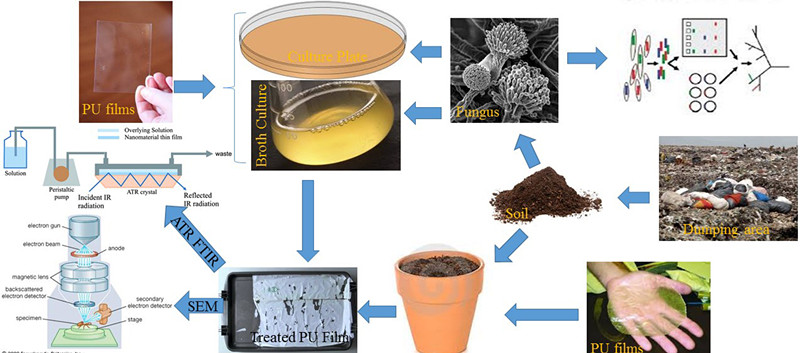
Nowdays, humans are producing ever greater amounts of plastic – much of which ends up as garbage. What’s more, because plastic does not break down in the same way as other organic materials, it can persist in the environment over extremely long periods of time.
Scientists from the Kunming Institute of Botany, Chinese Academy of Sciences have recently identified a fungus which could help deal with our waste problem by using enzymes to rapidly break down plastic materials.
Plastic is used in the manufacture of an astonishing variety of materials: from the phone or computer on which you’re reading this article, to the car, bus or bike you use to get around, and even in many clothes, plastics are ubiquitous in the modern world.
However, the tremendous increase in the production and use of various manmade plastics has become a huge threat to the environment: plastic waste can choke waterways and soils, release harmful chemicals, and even poses a threat to animals which can mistake plastic debris for food.
Plastic polymers take many years to decompose, as due to their xenobiotic nature – meaning that they did not exist before their synthesis by humans – they are not easily broken down by the bacteria, fungi and small creatures that feed on other waste matter. Even when they do somewhat degrade, tiny particles of plastic may persist in the environment, with unknown consequences for human and environmental health.
However, the authors of a new study titled “Biodegradation of Polyester Polyurethane by Aspergillus tubingensis” believe they may have found an unexpected solution to our growing plastic problem in the form of a humble soil fungus.
Attempts to deal with plastic waste through burying, recycling or incineration are variously unsustainable, costly and can result in toxic byproducts which are hazardous to human health.
The authors of the recent article, published in the journal Environmental Pollution, therefore argue that we urgently need to find new, safer and more effective ways to degrade waste plastics.
“we knew that one way to do this would be to look to solutions which already existed in nature, but finding microorganisms which can do the job isn’t easy”. In the end, the research team found their plastic-eating fungus living in an appropriate venue – a rubbish tip in Islamabad, Pakistan.
Watched by crows and vultures, the researchers took samples of soil and various pieces of rubbish in hopes of finding an organism which could feed on plastic waste in the same way that other fungi feed on dead plant or animal material.
Aspergillus tubingensis is a fungus which ordinarily lives in the soil. In laboratory trials, the researchers found that it also grows on the surface of plastics. It secretes enzymes onto the surface of the plastic, and these break the chemical bonds between the plastic molecules, or polymers.
Using advanced microscopy and spectroscopy techniques, the team found that the fungus also uses the physical strength of its mycelia – the network of root-like filaments grown by fungi – to help break apart the polymers. Plastics which persist in the environment for years can be broken down by A. tubingensis in a matter of weeks, the scientists say.
The fungus’ performance is affected by a number of environmental factors including pH, temperature and the type of culture medium used. According to Dr. Khan, “our team’s next goal is to determine the ideal conditions for fungal growth and plastic degradation”.
This could pave the way for large-scale use of the fungus in, for example, waste treatment plants, or for application in soils already contaminated by plastic waste. The discovery of A. tubingensis’ appetite for plastic joins the growing field of ‘mycoremediation’, which investigates the use of fungi in removing or degrading waste products including plastic, oil and heavy metals.
Mycologists estimate that only a small proportion of all fungi species have yet been described, which means that vast numbers of potentially useful species are still to be found. However, the destruction of habitats such as natural forests means that many fungi species are likely being lost before they can be identified, let alone tested for possible uses.
If this continues, we may come to rely more and more on those species we can find in man-made environments – and more scientists may find themselves doing fieldwork in rubbish tips rather than rainforests.

The Biodegradation Process by Fungi. (Image by KIB)

86-10-68597521 (day)
86-10-68597289 (night)

52 Sanlihe Rd., Xicheng District,
Beijing, China (100864)

